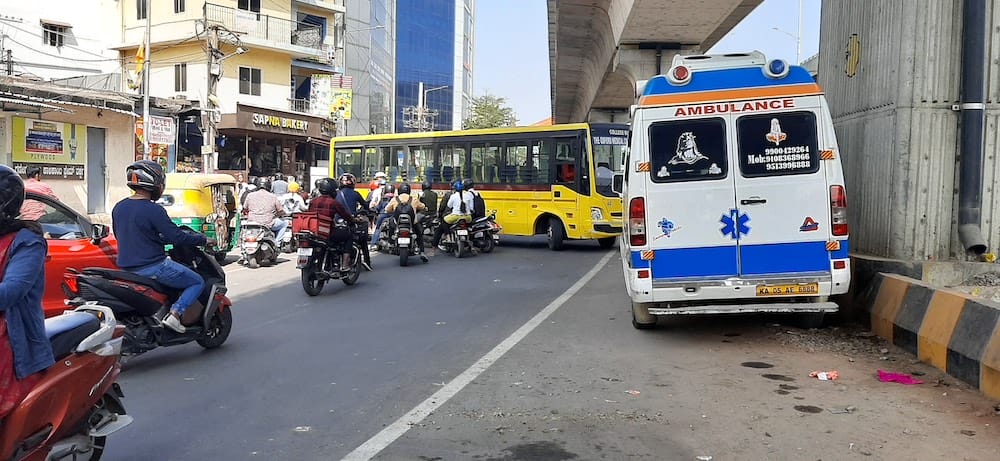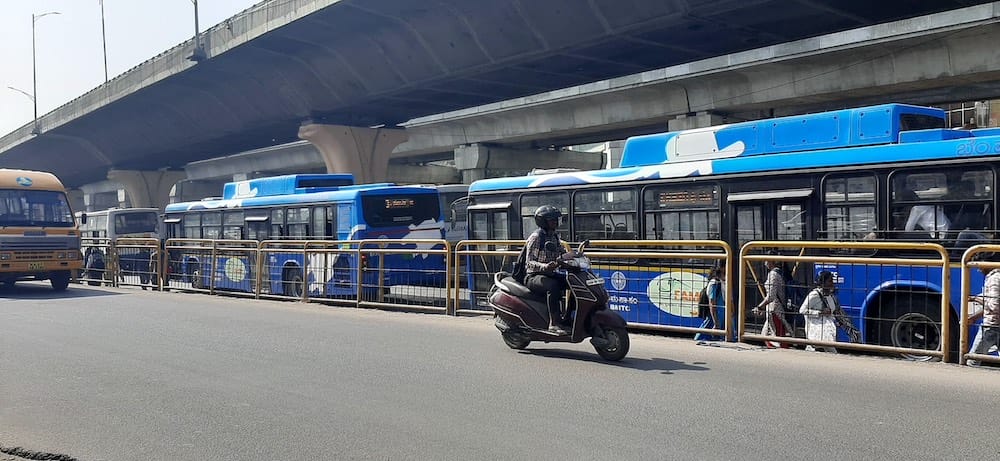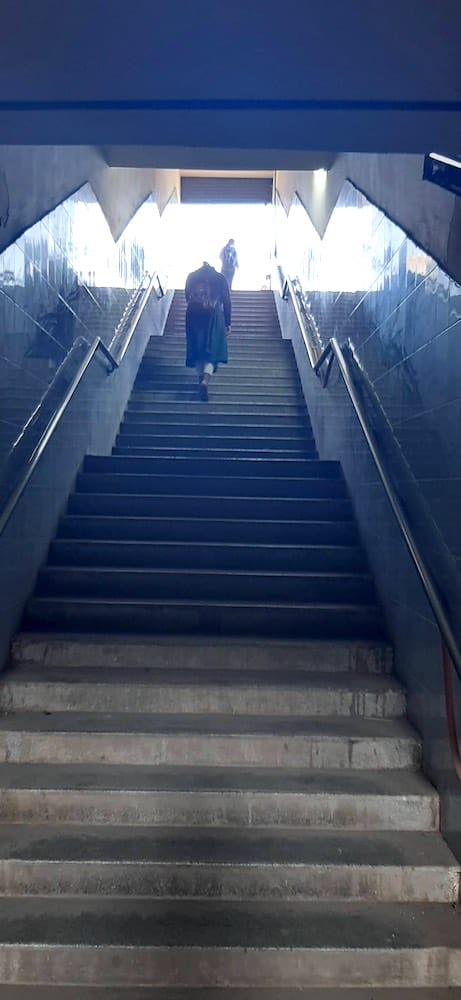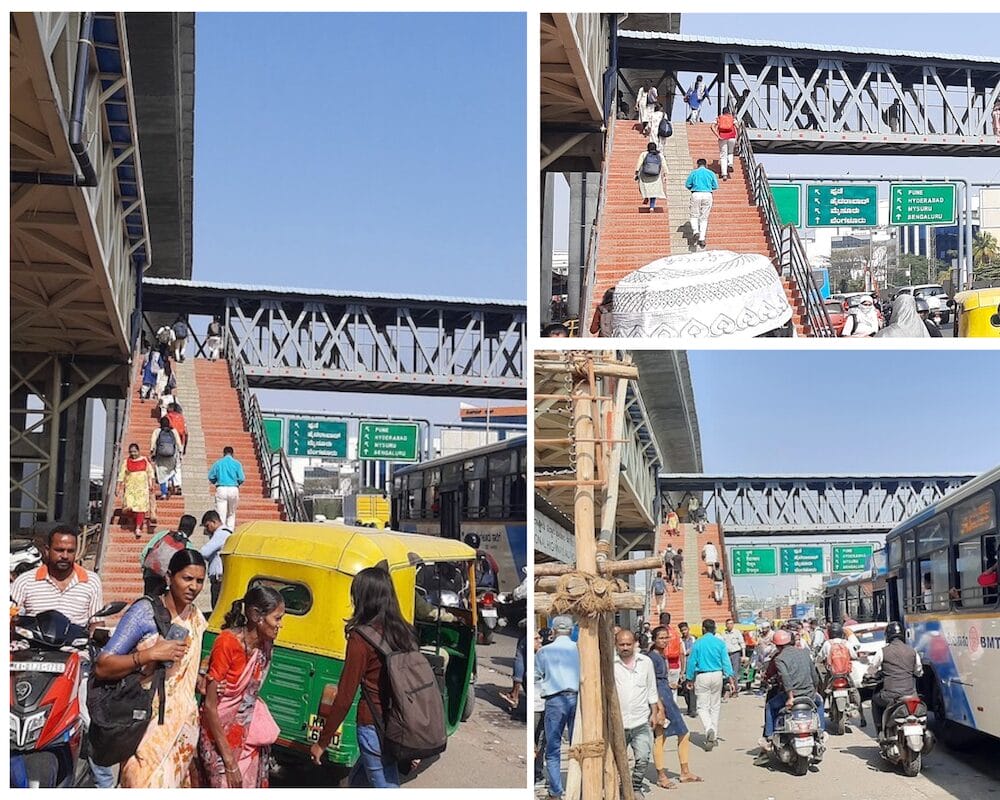The perception that HSR Layout is as an upmarket neighbourhood has led to public transport infrastructure being ignored in the area. The common notion is that its residents prefer to drive rather than use buses. The reality, however, is quite different. There is a large number of deprived communities who live in areas around HSR layout, such as Mangammanapalya, Parangipalya, Bommanahalli etc.
These communities rely heavily on public transport, which ply on busy roads such as Hosur Road, Outer Ring Road (ORR) and Sarjapur Road. The people here work long hours for a pittance, and commute long distances everyday. Unfortunately, they are the forgotten lot.
Hosur Road, ORR and Sarjapur Road are national and state highways. So, the priority for these roads has been historically for signal-free and fast vehicular movement. Silk Board and Electronic City flyovers on Hosur Road, and Agara flyover on ORR were built with this aim in mind. Ironically though, these roads also have good connectivity when it comes to buses. Hosur Road and Sarjapur Road have frequent buses plying towards the Central Business District (CBD).

Read more: Navigating pedestrian challenges at Iblur junction: A deep dive into issues and solutions
Footpaths and bus stops in poor condition
Most buses between Banashankari and the IT corridor pass via ORR. Additionally, many inter state and inter city buses ply on these roads. The frequency and connectivity of buses attract significant pedestrian movement on these roads. Despite this, there are no footpaths on Hosur Road, and footpaths on ORR and Sarjapur Road are either missing or are extremely narrow and filled with debris, making it unsuitable for walking.
Despite pedestrian deaths on Hosur Road, there are no improvements to pedestrian safety. Due to metro work, and the sheer volume of traffic, many sections of these roads are barricaded. This has increased the distance pedestrians have to walk on the road. They have to dodge traffic to cross the road or to change buses. Pedestrians are pushed precariously close to fast moving traffic and face unnecessary risks due to lack of decent footpaths.
Compounding the problems further is the ongoing Metro construction, and the locations and conditions of bus stops. Bangalore Metro Rail Corporation Limited (BMRCL) has made no provision for pedestrians in areas where metro work is ongoing and roads are closed.
The bus stop at Iblur junction, in one direction, is in utter shambles – the huge crowd of people have to compete for space with the buses and traffic. In the other direction, buses actually stop on the flyover. There are no proper, assigned bus stops all the way from Iblur to Silk Board, leave alone a bus shelter (except at Agara).
People have to stand on the roads because there are no footpaths. These stops get crowded, particularly during peak hours.

Silk Board bus stop can be described in one word-chaotic. Buses stop at the signal or right in the middle of the road, and so people have to navigate their way to the side.
At Bommanahalli bus stop on Hosur Road, buses going towards Electronic City stop on the main road. People heading towards HSR Layout and Mangammanpalya have to climb onto the service road, which is almost two feet above the level of the main Hosur Road. After that, they have to wait for motorists, plying on both sides of the service road, to slow down so that they can cross the road to get safely to Mangammanapalya Road.

Dangerous for pedestrians to cross
Pedestrian crossings are a further challenge. All the roads are extremely wide, and pedestrians have to run to cross the road before the signal changes to green.
Hosur Road does have a subway at Mangammanapalya junction and a skywalk at Rupena Agrahara. However, neither is accessible for the elderly or the disabled due to the nature of its design, location and steepness.


With the Yellow line coming up on Hosur Road and Blue line on ORR, we clearly see a contradiction of intent. Are these roads meant to prioritise private vehicles or public transport? If the intent is to encourage public transport, why is pedestrian infrastructure so abysmal? The bus stops dotted along these roads are often teeming with people.
Read more: What it takes to get a skywalk in Bengaluru
Make public transport comfortable and accessible
All the buses are full, especially during peak hours. For example, around 9 am, there are often two to three KBS 3A buses at the same time at Silk Board junction, and all of them are usually full. Imagine how many cars and bikes aren’t on this junction because people are in buses. A bus ferrying just 50 to 70 passengers can easily eliminate at least 30 vehicles off the roads because many cars and two wheelers are driven by one person, with no passengers in it. So, one can imagine how many vehicles can be off the roads if people chose to take buses.

Yet, why are there minimal efforts to improve the safety and comfort levels of the commuters in buses? Should we assume these commuters are silent because they accept what is dished out to them or because they feel helpless and have given up?
Accessibility and safety are the first steps to ensure a successful public transport system, which significantly reduces use of private vehicles.
Neglect of pedestrian access could be because of the false notion that people aren’t using public transport. Also, people are unable to use public transport because of its poor condition. This is a catch-22 situation, which won’t improve unless there is a genuine effort to gain back the public’s confidence to use public transport.
The quality of pedestrian access and public transport should be enhanced and made inclusive to benefit everyone. The need of the hour is to reclaim our roads for pedestrians and for citizens to vocalise their need for a better public transport system.
Excellent analysis of the current state of commuters who are taking public transport system out of choice or necessity. I hope through this article the authorities receive a wake up call to bring back the lost glory of the public transport system.
I travel to Wipro kodathi office on Sarjapur road from JP nagar 6th phase, o need to change 3 buses. There no direct bus from Banashankari bus stop to Kodathi office on Sarjapur road. I need to change the bus at iblur junction and at this junctions there no safety for pedestrian. Also returning to home also really dangerous to get a bus going towards Banashankari at iblur junction.
It’s an excellent write-up covering most of the issues. But excellent write-ups don’t solve the problem, they will be ignored as usual. Do we have any practical suggestions about how the situation can be improved? I have read somewhere how some European countries use Design Thinking to solve such issues or eliminate them in the initial design stage itself.
Very well said. Public in and around HSR have no access to safe public transport. I have been a resident here for 30 years. It was common for us to walk to Bommanahalli for busses.
In those days it was at least easy to walk as vehicles were less on roads. Today walking on the road is dangerous. Footpaths are missing or occupied by stores.
The bus stop at 9th Main is the most dangerous. People have to stand in the middle of the road to catch a bus.
All this has meant that HSR has been converted into a personal vehicle centre than a public transport mecca
The author has shown the correct picture. You said it the people are helpless and have given up. There are no footpaths added to that we have heaps of garbage, debris and construction materials lining the side of the roads. Why this apathy? I hope the blog will open the eyes of both authorities and the citizens. They fight about non issues like names of metro stations even before the metro itself has started functioning.